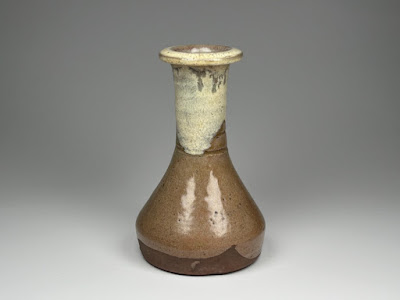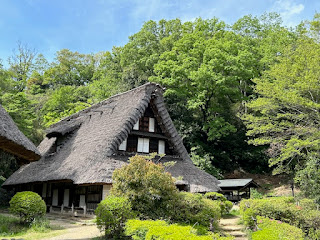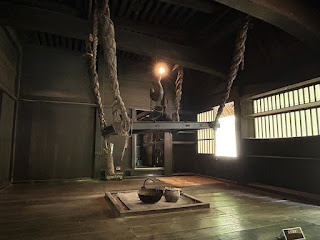酒津焼の花立 Sakazu Earthenware Flower Vase
神奈川県大和市で月1回やっているやまと古民具骨董市で手に入れた。店の主人によれば、岡山県倉敷市の酒津(さかづ)地区で、おおむね100年くらい前に焼かれたものという。ここ2年くらい、わたしは東北のやきものに興味をもって多少あつめてもいるが、当然のことだが、やきものの技術や意匠は突然変異的に発生するものではないから、西日本にも(もっと言えば朝鮮や中国にも)おなじような毛色のやきものを生産した窯が存在しており、この花立にもそういうシンパシーを感じた。赤褐色の土を三角フラスコみたいな形につくり、黄土色と白色の釉をかけている。首の真ん中あたりの2本の筋目が全体を引き締めている。いわゆる仏花器、もしくは神前に供える榊立(さかきたて)で、酒津では相当量産したものらしい。
I obtained this earthenware at a flea market held once a month in Yamato City, Kanagawa. An antique dealer said it was baked in the Sakazu district, Kurashiki City, Okayama, about 100 years ago. I have been interested in old Tohoku earthenwares in the last two years, and acquired some. As the art of pottery does not suddenly emerge, there can be some similarities between Tohoku and other western Japanese (and also Chinese and Korean) ceramic wares. I felt a flavor of Tohoku potteries in this yellowish brown and white glazes over a red-brown body like a flask. Two lines engraved at the middle makes it better. This was a vase to put in flower or sakaki (green leaves) in a religious situation, and this kind of vase was one of the Sakuzu pottery's main products.
文献によると、酒津焼は八幡山(倉敷市街から北西に 4 km ほどに位置する;別名、兜山)の麓に陶土を見出した岡本末吉が明治のはじめ頃に創業した。萩や伊部などから職人を呼んで生活雑器を盛んに生産した。しかし大正年間頃(1920年頃)から安い磁器製品に需要を奪われ、さらに高梁川の流路変更工事(明治43年〜大正14年)で窯元と市街地とが川で分断されたこともあいまって、衰退の危機にあったところ、当時勃興した民藝運動の後押しにより息を吹き返し、その後いくつかの脇窯の創始もあり現在に至っている。この花立が民藝運動前のものか後のものか定かでないが、当時の需要に裏付けられた用の美にあふれる小品だとおもう。
Literatures say that Okamoto Suekichi found a good clay near Mt. Hachiman-yama (Kabuto-yama), about 4 km northwest from Kurashiki city center, and built a kiln nearby in 1870s. He invited potters from Hagi and Inbe that were active potteries at that time, and produced daily-use earthenwares. In 1920s, the business declined because of prevalence of mass-produced porcelains and a public work to change the path of Takahashi River by which the pottery and the city were divided. However, support from the folk-arts movement by Yanagi Muneyoshi was so strong that the Sakazu pottery prolonged the business to the present. I am not sure whether this vase was produced before or after the the folk-arts movement. Anyway, it will be a piece of nice folk arts that were requested by users.
参考
- 「わがまち倉敷」川崎製鉄水島製鉄所、1981年
- 「現在の日本民窯」民藝叢書 3、柳宗悦・式場隆三郎 編集、昭和書房、1942年
- 酒津焼窯元のホームページ。
- 倉敷酒津焼兜山窯のホームページ。いずれも初代末吉の末裔が作陶している。
やまと古民具骨董市にははじめて行ったのだが、駅前の通りに多数の露店が並んでいて、こういうのが好きな人にはたまらない催しだろう(公称 300 店ということだが、実際そのくらいあったとおもう)。その後、生田緑地に足を伸ばして、日本民家園と川崎市岡本太郎美術館を訪ねた。民家園は、おもに江戸期に建てられた全国各地の民家を多数移築、保存した野外博物館で、これが川崎市単独の事業であることに驚きを禁じえない。ちょうど土曜日で多数のボランティアスタッフの方が働いていた。市の予算も限られていると想像されるなか、こうした支援活動は貴重なものである。ちょっと川崎市に移住したくなった。
The Yamato antique market was unexpectedly large-scale; the organizer's advertisement that 300 dealers monthly gather is not false. After that, I went to Ikuta Ryokuchi Park to see Japan Open-Air Folk House Museum and Okamoto Taro Museum, the former displaying many old houses mostly built in the Edo era (more than 150 years ago) and moved to this place from everywhere in Japan. It was surprising that this big project was solely organized by Kawasaki City. It was Saturday and many voluntary staff worked there, which would be helpful because Kawasaki City's budget for cultural activity might not be very enough. A sudden thought of moving to Kawasaki crossed my mind.





